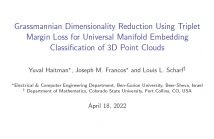
ICASSP 2022 - IEEE International Conference on Acoustics, Speech and Signal Processing is the world’s largest and most comprehensive technical conference focused on signal processing and its applications. The ICASSP 2022 conference will feature world-class presentations by internationally renowned speakers, cutting-edge session topics and provide a fantastic opportunity to network with like-minded professionals from around the world. Visit the website.

- Read more about Fine-Grained Dynamic Loss for Accurate Single-Image Super-Resolution
- Log in to post comments
- Categories:
 20 Views
20 Views
- Read more about A NON-CONVEX PROXIMAL APPROACH FOR CENTROID-BASED CLASSIFICATION
- Log in to post comments
slides_ICASSP_2022.pdf
- Categories:
 19 Views
19 Views
- Read more about SPE-89.4: UNSUPERVISED DATA SELECTION FOR SPEECH RECOGNITION WITH CONTRASTIVE LOSS RATIOS
- Log in to post comments
This paper proposes an unsupervised data selection method by using a submodular function based on contrastive loss ratios of target and training data sets. A model using a contrastive loss function is trained on both sets. Then the ratio of frame-level losses for each model is used by a submodular function. By using the submodular function, a training set for automatic speech recognition matching the target data set is selected.
- Categories:
 41 Views
41 Views
- Read more about Constant Q Cepstral Coefficients for Normal vs. Pathological Infant Cry
- Log in to post comments
- Categories:
 28 Views
28 Views
- Read more about DEEPFAKE SPEECH DETECTION THROUGH EMOTION RECOGNITION: A SEMANTIC APPROACH
- Log in to post comments
In recent years, audio and video deepfake technology has advanced relentlessly, severely impacting people's reputation and reliability.
Several factors have facilitated the growing deepfake threat.
On the one hand, the hyper-connected society of social and mass media enables the spread of multimedia content worldwide in real-time, facilitating the dissemination of counterfeit material.
- Categories:
 43 Views
43 Views
- Read more about Grassmannian Dimensionality Reduction Using Triplet Margin Loss for UME Classification of 3D Point Clouds
- Log in to post comments
- Categories:
 15 Views
15 Views
Feature selection has been explored in two ways, global feature selection and instance-wise feature selection. Global feature selection picks the same feature selector for the entire dataset, while instance-wise feature selection allows different feature selectors for different data instances. We propose group-wise feature selection, a new setting that sits between global and instance-wise feature selections.
- Categories:
 24 Views
24 Views
- Read more about VADOI: VOICE-ACTIVITY-DETECTION OVERLAPPING INFERENCE FOR END-TO-END LONG-FORM SPEECH RECOGNITION
- Log in to post comments
While end-to-end models have shown great success on the Automatic Speech Recognition task, performance degrades severely when target sentences are long-form. The previous proposed methods, (partial) overlapping inference are shown to be effective on long-form decoding. For both methods, word error rate (WER) decreases monotonically when over- lapping percentage decreases. Setting aside computational cost, the setup with 50% overlapping during inference can achieve the best performance. However, a lower overlapping percentage has an advantage of fast inference speed.
VADOI Poster.pdf
- Categories:
 29 Views
29 Views